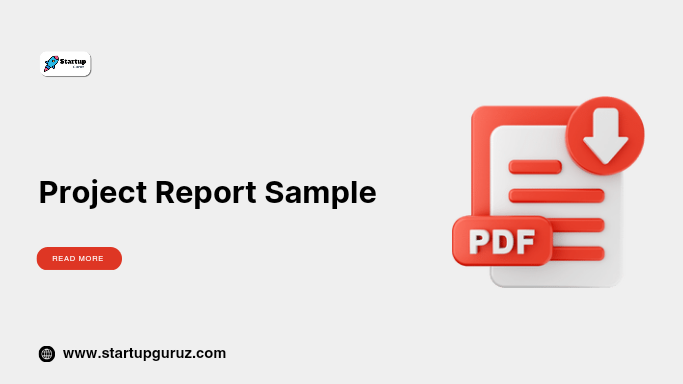Project Report Sample
Comprehensive Guide to Project Report Sample
A project report is a structured document that provides details about a business idea, project, or activity, emphasizing its feasibility, goals, and implementation strategy. This document is essential for businesses seeking funding, government approvals, or internal planning. This guide explains how to create a compelling project report, with an example, tips, and FAQs to make the process easier.

What is a Project Report?
A project report is a formal document that outlines the key aspects of a project. It serves as a roadmap, covering details such as the project’s purpose, financial needs, technical requirements, risks, and projected outcomes.
Importance of a Project Report:
- Funding Applications: Banks and investors require a project report to assess the viability of the project.
- Strategic Planning: It serves as a blueprint for execution.
- Risk Analysis: Helps identify and address potential risks.
- Transparency: Ensures all stakeholders have a clear understanding of the project.
Key Components of a Project Report
1. Executive Summary
This section summarizes the project, including its purpose, goals, and financial requirements.
Example:
“The proposed project involves setting up an organic farming business with an investment of ₹30,00,000. The aim is to produce high-quality organic vegetables and fruits while promoting sustainable agriculture practices.”
2. Project Objectives
Define the specific objectives the project aims to achieve.
Example:
- To establish a state-of-the-art facility for organic farming.
- To generate a revenue of ₹1 crore annually within three years.
- To promote employment opportunities in rural areas.
3. Business Overview
Describe the business, its legal structure, and ownership details.
Example:
- Business Name: Green Agro Solutions Pvt. Ltd.
- Ownership Type: Private Limited Company.
- Promoters: Mr. Ramesh Sharma, Ms. Pooja Verma.
4. Market Analysis
Analyze the market trends, target audience, competitors, and growth potential.
Key Points to Include:
- Market size and growth rate.
- Demand and supply analysis.
- SWOT analysis of competitors.
Example:
“The organic food market in India is growing at 20% annually, driven by increasing health awareness and government support.”
5. Technical Feasibility
Explain the technical aspects of the project, including infrastructure, machinery, and processes.
Example:
“The project will utilize drip irrigation technology and organic manure to ensure high-quality produce and efficient water usage.”
6. Financial Plan
Include details about the project’s costs, funding requirements, and revenue projections.
Example of Cost Breakdown:
| Expense | Amount (₹) |
|---|---|
| Land Acquisition | 10,00,000 |
| Equipment and Machinery | 8,00,000 |
| Marketing and Branding | 3,00,000 |
| Working Capital | 9,00,000 |
| Total | 30,00,000 |
7. Implementation Plan
Provide a timeline and milestones for the project.
Example:
| Milestone | Timeline |
|---|---|
| Land Purchase | Month 1 |
| Equipment Setup | Month 2-3 |
| Operations Start | Month 4 |
8. Risk Analysis and Mitigation
Identify potential risks and propose solutions to mitigate them.
Example:
- Risk: Unfavorable weather conditions.
- Mitigation: Invest in greenhouse technology.
9. Sustainability Measures
Outline steps to ensure the project is environmentally and socially sustainable.
Example:
“The project will adopt renewable energy sources and minimize chemical usage to promote sustainability.”
10. Conclusion and Recommendations
Summarize the report and provide recommendations for moving forward.
Example Project Report Outline
Here’s a sample outline for a restaurant project report:
- Executive Summary: Overview of the restaurant concept, investment needs, and expected outcomes.
- Objectives: To serve healthy and affordable food in urban areas.
- Market Analysis: Study of local competitors, target audience demographics, and dining trends.
- Technical Feasibility: Layout of the restaurant, kitchen equipment, and staffing needs.
- Financial Plan: Capital requirements, revenue projections, and ROI.
- Risk Assessment: Challenges like fluctuating food costs and mitigation strategies.
- Implementation Plan: Construction timeline and launch schedule.
- Conclusion: Final summary and call to action for funding approval.
How to Create an Effective Project Report
Tips for Writing a Project Report
- Be Concise: Avoid lengthy descriptions; focus on key points.
- Use Data and Visuals: Incorporate charts, graphs, and tables to present information clearly.
- Tailor the Report: Customize it based on the project’s nature and audience.
- Focus on Financials: Ensure accuracy in cost and revenue projections.
- Proofread: Eliminate grammatical errors and inconsistencies.
FAQs About Project Report Samples
1. What is a project report sample?
A project report sample is a template or example that provides a structured format for creating a project report.
2. Why is a project report important?
It helps stakeholders understand the project’s feasibility, financial requirements, and implementation strategy, making it essential for funding and planning.
3. How do I create a project report?
Follow a structured format, include detailed financials, conduct market analysis, and outline risks and mitigation strategies.
4. Can I use a generic template for my project report?
Yes, but customize it to suit your project’s specific requirements and objectives.
5. What financial details should be included in a project report?
Include costs, revenue projections, working capital, and ROI analysis.
6. How long should a project report be?
The length depends on the complexity of the project but typically ranges from 10-30 pages.
7. Do I need professional help to create a project report?
Not always. However, for complex projects or bank loans, seeking expert assistance can enhance accuracy and presentation.
8. How often should I update my project report?
Update it whenever there are significant changes in project scope, financials, or market conditions.
9. What tools can I use to create a project report?
Use tools like Microsoft Word, Excel, and project management software for better formatting and data analysis.
10. Is a project report mandatory for a bank loan?
Yes, most banks require a detailed project report to evaluate the feasibility and risk of the proposed business or project.